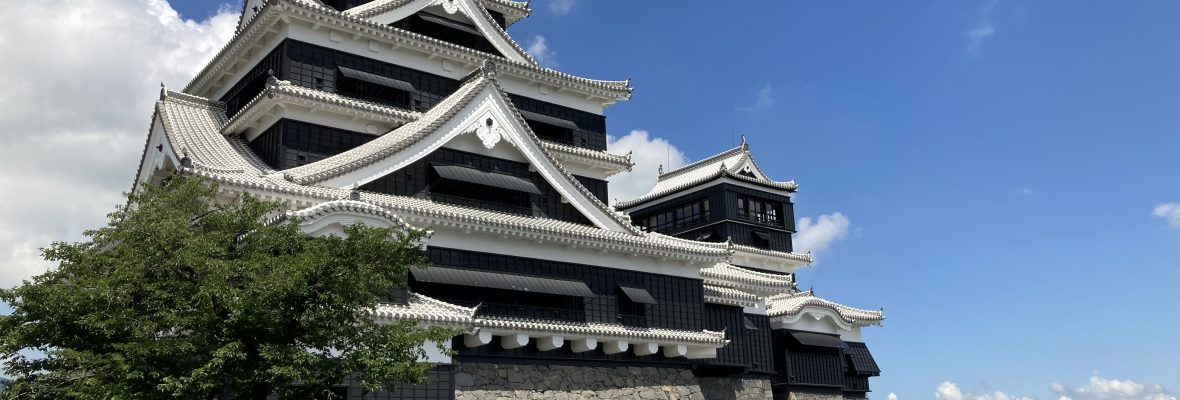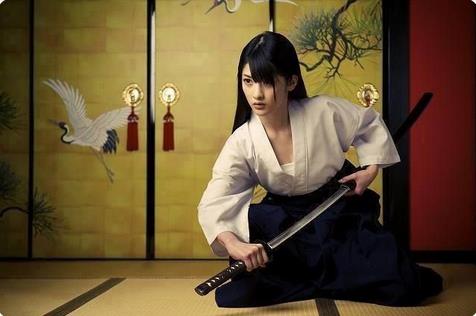Everybody knows about Japan and their samurai. But did you know men were not the only ones being trained to kill, lead, and fight with deadly weapons back in feudal Japan? Lesser known than their male counterparts, the Onna Bugeisha played an important role in Japan’s history and Empress Jingu is perhaps the most legendary Onna Bugeisha of them all. But first, let’s explore what an Onna Bugeisha really is.
A Force to be Reckoned With
Onna Bugeisha (lit. female master of martial arts) were more or less the female equivalent of samurai and a type of female warrior way back when in the olden times of feudal Japan. They belonged to an upper class of warriors known as bushi and even fought alongside male samurai in righteous battle and were usually the last line of defense at their home castle.
These fierce females played a very important role in the time of feudal Japan but for some reason they don’t seem to get much recognition in the history books.
I am not quite sure as to why they seem to get the short end of the stick here, but perhaps the male writers of the history books did not like their manliness being challenged by these femme fatales, or perhaps the answer lies somewhere else, who can say. Either way, I think these female warriors are pretty awesome and definitely worth learning about. Let’s move on, shall we?
Early History of the Onna Bugeisha
Even before the emergence of the legendary samurai and the bushi class, Japanese villages needed to be protected from all sorts of attackers. Since the men of the village weren’t always around (hunting, fishing, travelling to Fuji-Q Highland) the women needed to be able to defend themselves and the village should the need arise.
Even so, women warriors were definitely not a common sight on the battlefield. The Japanese idea of what a female should be like and what role she should fill in society were not much different from many cultures at the time. A woman was expected to be obedient, frail, and powerless when compared to her male counterpart in society. This traditional view of women did not rub well with the idea of a female warrior slaying enemies on the battlefield or wielding a deadly weapon.
In these fierce and bloody conflicts, male warriors most often used swords and spears and were highly trained with them. The women, however, were more likely to be trained in the naginata (pole-arm), kaiken (dagger), and tanto (knife) for use in battle. These weapons were easier to use and conceal in the case of the short blades, and the naginata’s length made up for most any strength the Onna Bugeisha’s female frame may have been lacking.
Weapons of the Onna Bugeisha
Probably the most popular weapon of choice for Onna Bugeisha was the naginata, a long rod with a curved blade at one end. Due to its length, it became very popular as it was easy to keep attackers at bay and counter attackers riding on horseback.
Because of this, it was easier for the Onna Bugeisha to fight male warriors at a bit of a distance which allowed them to make up for any lack of strength. Since the male attacker was unable to get into hand to hand or close quarters combat, they were unable to overpower the well trained naginata wielders and most likely brought much shame upon their families for getting owned so hard.
Even though other weapons were commonly used as well (kaiken, tanto, bow and arrow, etc) the naginata ended up becoming synonymous with the Onna Bugeisha image. Because of this, many onna bugeisha schools were founded in the beginning of the Edo period and focused mainly on the naginata for their training.
The Edo Period and the Fall of Onna Bugeisha
However, and unfortunately for the Onna Bugeisha, the Edo period also brought about a lowering to the status of Onna Bugeisha in society. This was due mostly to the influence of Neo-Confucian thought and the established marriage market of the time. As samurai’s focus changed from war and battle to issues of politics and bureaucracy, the Onna Bugeisha’s role in society drastically changed.
No longer were they fighting fearlessly in battle, these once mighty women were relegated to housemaids, trophy wives, and bargaining chips in deals of succession. Their once burning spirit was placated and pacified into one of quiet, passive obedience.
With the advent of the 17th century, the woman’s role in society had been cemented as a role of childbearing. With this new mindset the image of a female warrior was even more out of place in society than it might have been before. As such, the idea of females fighting in battle any longer was more or less snuffed out and the traditional Onna Bugeisha was no longer. Women were now viewed as baby machines and not much else.
But while their progress may have been halted by bureaucracy and the changing role of women in Japan, their legacy lives on in legendary tales of their power and bravery. And one of the most legendary and impressive Onna Bugeisha was one Empress Jingu.
The Legend of Empress Jingu
Empress Jingu (c. AD 169-269) was consort to Emperor Chuai and served as regent of Japan from 209 when Chuai died until 269 when her son Ojin ascended. There is much mystery and legend surrounding Empress Jingu as a historical figure. As there is insufficient records available concerning her and her reign in Japan, many are unsure as to how much of the legends are true. Regardless, the legends themselves are pretty awesome.
Aided by a pair of divine jewels allowing her to control the tides, legend has it she led a successful invasion of Korea in the year 200 without shedding a single drop of blood. However, the belief that Korea was invaded during this time is widely rejected historically, even in Japan. This is because there is debatable historical evidence of Japanese rule in Korea during this time. However, sources state that Japan had at least developed some control over southern Korea by the 4th century.
Legend also states that her son Ojin was born upon her return to Japan in 203. As he was conceived before she went to battle in Korea and born upon her return, he remained in her womb for three years. The legendary explanation for this is that he son was actually Hachiman, the god of war, and he willfully remained in her womb those three years to give her the time she needed to conquer Korea.
A Lasting Legacy
Empress Jingu has been depicted in many vernacular narratives, paintings, and sculptures. Many regarded her as a living goddess, mother of the martial deity Hachiman, and the mighty conqueror of the Korean kingdoms. These powerful aspects represented all of Japan’s newfound colonial aspirations. It just made sense to choose Empress Jingu as the new face on Japan’s paper money.
In 1881, Empress Jingu became the first woman to be featured on a Japanese banknote. However, since no actual images of her are known to exist (only woodcarvings and the like), the artistic representation of Empress Jingu is entirely conjectural as I’m sure you can tell from the above picture.
Although the final resting place of Empress Jingu remains unknown, her officially designated tomb is located at Misasagi-cho in Nara. This sort of kofun tomb is characterized by a keyhole-shaped island located within a wide, water-filled moat.
But regardless of the validity of the stories surrounding this legendary figure, she no doubt has inspired many generations of Japanese people, both men and women alike. Along with the rest of the Onna Bugeisha, she fully represents the strength and resolve of Japanese women everywhere.
Source – Tofugu.






Hi, i’m recently became very interested in the Onna Bugeisha and their complete disappearance during the Edo period. Do you have any sources/evidence in which you got all this information? I really enjoyed reading it 🙂
LikeLike
Hi, thanks for your reply. I have many books and journal articles where I get my information from. Please look at the page that lists all the books and articles I have. Otherwise you can do a search of academic journals on key words. eg onna bugeisha, Empress Jungu etc. The onna bugeisha were basically a role for the period they lived. After the Edo period began both the male and female samurai became relics under the Tokugawa. Simply, men took on administrative work and women stayed home. If you have any other questions please fell free to ask.
LikeLike
Hi again! Sorry for the trouble, i’m quite new to this website and don’t seem to understand where i can fine ‘the page that lists all the books and articles (you) have’. If you don’t mind, i would appreciate it if you could explain! Thank you!
LikeLike
No worries. You can find page 2 info by scrolling to the end of the front page and you can see the link under the tags.
LikeLike
I am currently writing a history of women in antiquity, The five-book series, entitled Power Women: Lessons from the Ancient World, includes Japanese women: Empresses, Consorts, and Concubines. Although the Shogunate period is not included in my coverage of ancient years, my research reveals that Confucianism was tightly embraced during the Tokugawa period. Confucius changed women’s status from relative freedom to work outside the home and participate in community affairs to serving mothers-in-law as virtual slaves and producing babies. Relegated to work inside the home, devoting herself to a life of service to the family was an honorable endeavor, no doubt, but Confucianism put an end to women’s identity
A near-contemporary of Aristotle and Plato, Confucius blocked women from any form of equality in the early years. Women warriors was an absurdity in his philosophy.
LikeLike
Sounds interesting. Yes, when Ieyasu Tokugawa took control in 1603 many things changed in society. I think it was mainly due to the increasing Christian influence in Japan that led Tokugawa to restore traditional belief systems, but under tighter control of the state. The Tokugawa also wanted to cement their power throughout all Japan and this was achieved through childbirth. In the end, virtually all regions of Japan were administered by a Tokugawa family member. As the traditional ‘male’ samurai class took on everyday administration duties, the woman’s role, as you say, changed dramatically. But in saying that the woman/mother still actually had a lot of power, not as a warrior but as the head of the household and family. I can still see this role with Japanese women today, mainly as I am married to a Japanese woman but also with the experience I have had living in Japan.
LikeLike
Thankyou for your comment. I’m looking forward to the release of the game, it looks great. Yes, up until the Edo period many women stood together with their family and fought hand in hand. As I mentioned in a previous comment, this fighting spirit is still with Japanese women these days although it’s usually not out in the public but the way they control and look after the family.
LikeLike